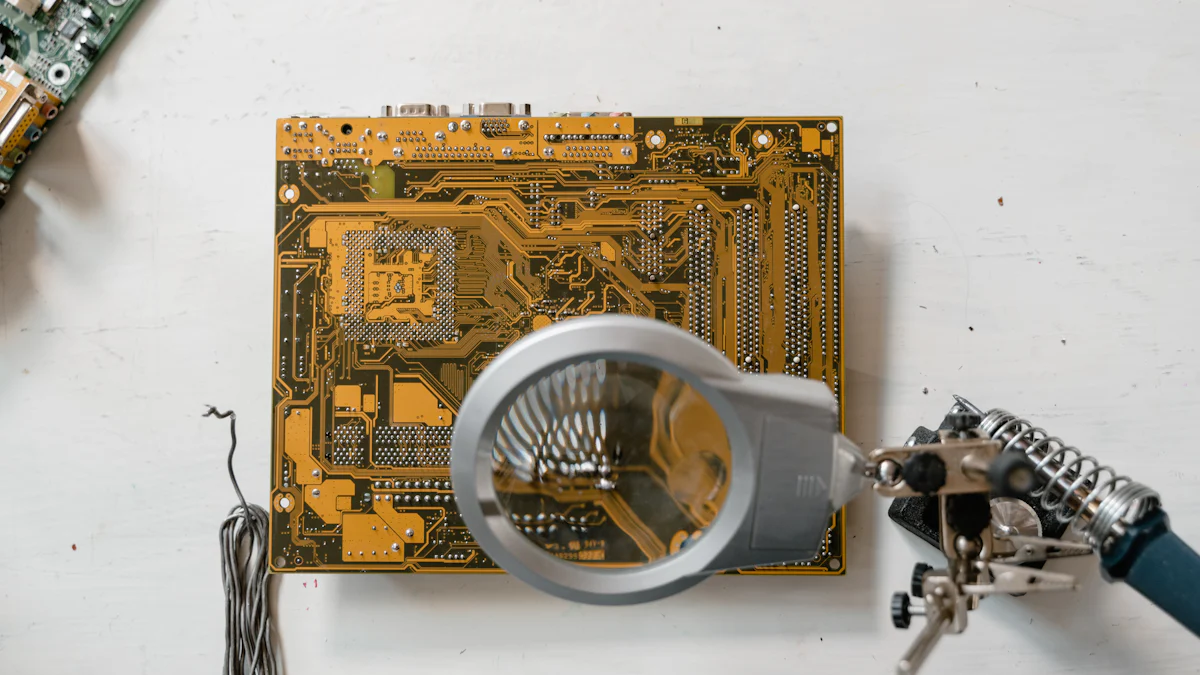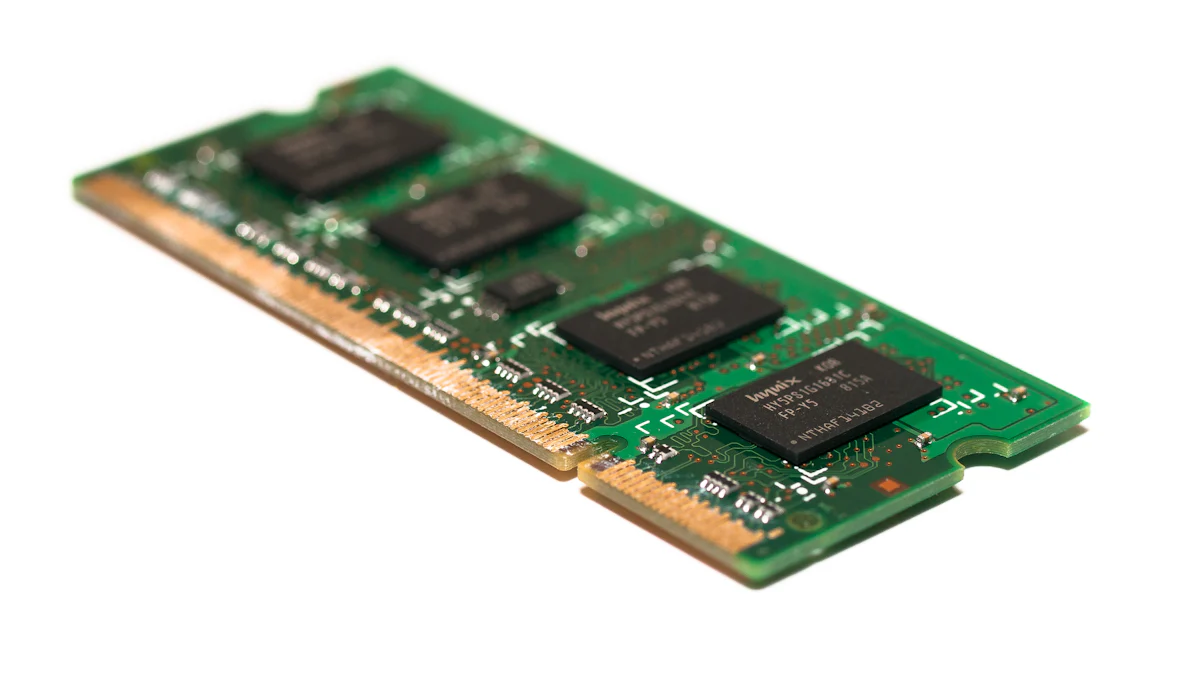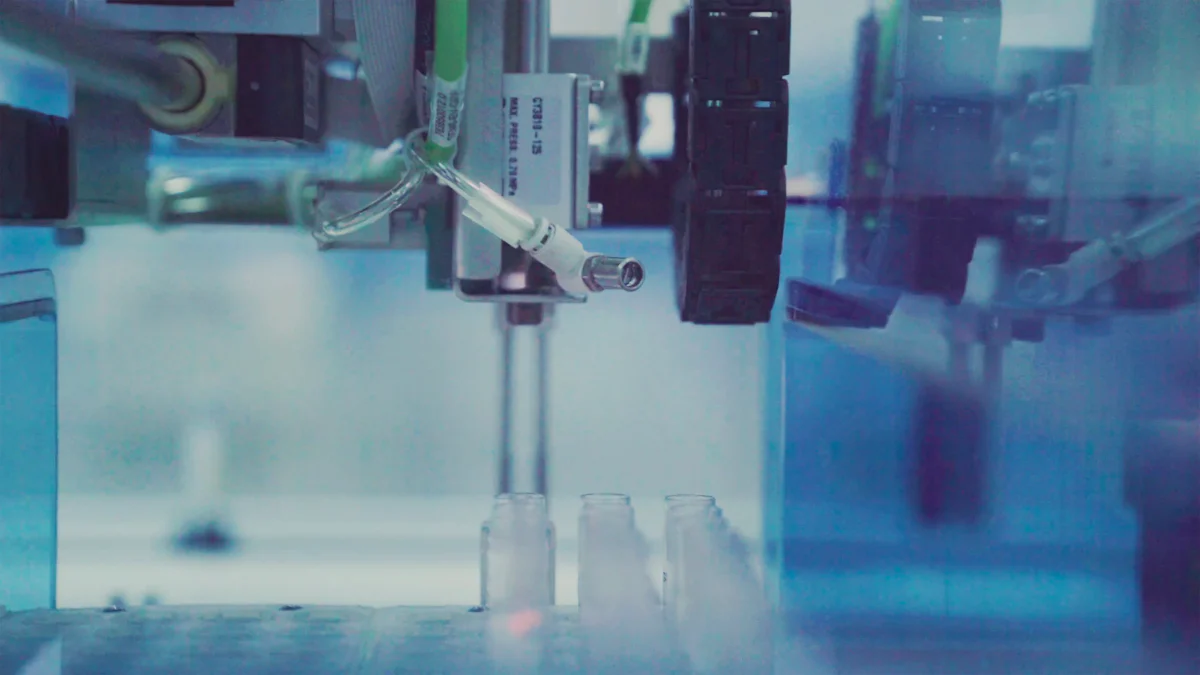
Les wafers en carbure de silicium (SiC) revêtus de graphite sont devenus essentiels dans les industries qui exigent la précision et la durabilité dans des conditions extrêmes. Leur combinaison unique de haute stabilité thermique, de résistance chimique et de résistance mécanique les rend indispensables pour des applications à haute température. Ces wafers en graphite revêtus SiC excellent dans des environnements comme la fabrication de semi-conducteurs et la production de cellules photovoltaïques, où le maintien de l'intégrité des matériaux est essentiel. Le revêtement SiC sert de barrière de protection, réduisant les risques de contamination et améliorant l'efficacité opérationnelle. Cette innovation non seulement simplifie la maintenance mais assure également des performances cohérentes, même dans les processus industriels les plus exigeants.
Principaux enseignements
- Les wafers en graphite revêtus de SiC sont essentiels dans la fabrication de semi-conducteurs, offrant une grande stabilité thermique et une résistance chimique pour des procédés comme DCV et le PECVD.
- Le revêtement SiC minimise les risques de contamination, assure l'intégrité des plaquettes et améliore la qualité des dispositifs semi-conducteurs.
- Dans la production de cellules photovoltaïques, ces gaufres supportent l'alignement et la stabilité précis des gaufres pendant le tranchage à haute température, ce qui améliore l'efficacité des cellules solaires.
- Leur durabilité et leur résistance à l'usure font du graphite enduit SiC une solution rentable, permettant une utilisation répétée dans des procédés industriels exigeants.
- Ces bateaux excellent dans l'aérospatiale et les applications de défense, fournissant des performances fiables dans des conditions extrêmes et soutenant la fabrication de composants résistants à la chaleur.
- Les wafers en graphite revêtus de SiC améliorent l'efficacité opérationnelle en assurant une distribution uniforme de la chaleur, en réduisant les défauts et en réduisant au minimum les besoins d'entretien.
- Au fur et à mesure que les industries évoluent, la demande de Bateaux à graphite revêtus de SiC continuera de croître, renforçant leur rôle crucial dans les progrès technologiques modernes.
Applications in Semiconductor Manufacturing

Rôle dans le traitement des déchets
Dépôt de vapeur chimique (CVD) et dépôt de vapeur chimique amélioré par le plasma (PECVD)
Dans la fabrication de semi-conducteurs, bateaux à graphite enduit de sic jouer un rôle central dans des processus comme le dépôt de vapeur chimique (CVD) et le dépôt de vapeur chimique amélioré par le plasma (PECVD).
Le résistance chimique du revêtement SiC protège également les embarcations de gaufrage contre les gaz corrosifs utilisés dans les procédés CVD et PECVD.
Procédés de diffusion et d'oxydation
La diffusion et l'oxydation sont des étapes critiques de la fabrication des semi-conducteurs, où des conditions thermiques précises sont essentielles. Bateaux à graphite revêtus de Sic excellent dans ces processus en raison de leur capacité à résister à des températures extrêmes sans déformer ni dégrader. Le revêtement SiC garantit que les bateaux restent inertes chimiquement, même lorsqu'ils sont exposés à des environnements réactifs pendant l'oxydation.
La conception de ces wafers, souvent munis de fentes pour tenir solidement les wafers, assure une exposition uniforme à l'environnement de diffusion ou d'oxydation. Cette uniformité est essentielle pour obtenir des propriétés électriques cohérentes dans tous les wafers. Les fabricants comptent sur ces bateaux pour maintenir la précision du processus et améliorer l'efficacité globale de la production de semi-conducteurs.
Avantages en semi-conducteur Production
Distribution uniforme de la chaleur pour une qualité constante des plaquettes
La distribution uniforme de la chaleur est la pierre angulaire du succès de la fabrication de semi-conducteurs. Bateaux à graphite revêtus de Sic assurer une conductivité thermique supérieure, en veillant à ce que la chaleur soit répartie uniformément sur toutes les plaquettes pendant le traitement. Cette uniformité empêche la surchauffe ou le refroidissement localisé, ce qui pourrait entraîner des défauts ou des incohérences dans le produit final.
Le revêtement SiC améliore encore les performances thermiques en réduisant les effets thermiques sur les plaquettes. Cette gestion précise de la chaleur soutient la production de semi-conducteurs de qualité constante, répondant aux normes strictes de l'industrie.
Prévention de la contamination par le revêtement SiC
La contamination pose un défi important dans la fabrication de semi-conducteurs. Le revêtement SiC sur les bateaux de graphite agit comme une couche protectrice, protégeant les wafers du contact direct avec le matériau du bateau. Cette barrière réduit le risque de transfert d'impuretés vers les wafers, ce qui est essentiel au maintien de leur intégrité.
De plus, les faibles taux d'évaporation des matériaux et d'adsorption des gaz des bateaux revêtus de SiC réduisent encore les risques de contamination. En assurant un environnement de traitement propre, ces bateaux aident les fabricants à obtenir des rendements plus élevés et à produire des dispositifs semi-conducteurs fiables.
Utilisation dans la production de cellules photovoltaïques

Soutien à la fabrication de la cire de silicone
Stabilité lors de la coupe à haute température de lingots de silicium
La fabrication de plaquettes de silicium exige précision et stabilité, en particulier lors du découpage des lingots de silicium à des températures élevées. Les graphite enduit de sic offre une stabilité thermique exceptionnelle, garantissant que le processus de coupe reste cohérent et précis. Cette stabilité minimise le risque de déformation ou de fissuration dans les plaquettes, ce qui est essentiel au maintien de leur intégrité structurale.
Le revêtement SiC agit comme une couche protectrice, protégeant le noyau de graphite de la chaleur intense générée au cours du processus de tranchage. Cette caractéristique permet non seulement d'améliorer la durabilité du bateau, mais aussi de garantir que les wafers restent exempts de contamination. En maintenant un environnement stable et propre, ces bateaux contribuent à la production de plaquettes de silicium de haute qualité, qui servent de base à des cellules photovoltaïques efficaces.
Résistance aux réactions chimiques lors du nettoyage des plaquettes
Le nettoyage des wafers est une étape essentielle de la production de cellules photovoltaïques, car il élimine les impuretés et prépare les wafers pour les processus ultérieurs. Les graphite enduit de sic présente une résistance remarquable aux réactions chimiques, ce qui en fait un choix idéal pour cette étape. Le revêtement SiC empêche le bateau de réagir avec les agents de nettoyage agressifs utilisés dans le processus, assurant ainsi sa longévité et sa fiabilité.
Cette résistance chimique protège également les wafers contre une contamination potentielle, en préservant leur pureté et en améliorant leur performance. En soutenant un processus de nettoyage propre et contrôlé, ces gaufres jouent un rôle vital dans l'optimisation de l'efficacité des cellules photovoltaïques.
Améliorer l'efficacité des cellules solaires
Précision dans l'alignement des plaquettes pour une performance optimale
Un alignement précis des plaquettes est crucial pour maximiser les performances des cellules solaires. Les graphite enduit de sic offre un positionnement précis des wafers, garantissant que chaque wafer est parfaitement aligné pendant le traitement. Cette précision minimise les problèmes de désalignement, qui peuvent nuire à l'efficacité des cellules solaires.
Le revêtement SiC améliore encore ce processus en fournissant une surface lisse et stable pour les wafers. Cette stabilité réduit la probabilité de contraintes ou de dommages mécaniques, permettant aux wafers de maintenir leur structure optimale. En conséquence, les fabricants peuvent atteindre des taux de conversion d'énergie plus élevés dans leurs cellules solaires, répondant ainsi à la demande croissante de solutions efficaces pour les énergies renouvelables.
Réduction des défauts lors des traitements thermiques
Les traitements thermiques, comme le recuit et la diffusion, sont essentiels pour améliorer les propriétés électriques des cellules solaires. Les graphite enduit de sic excelle dans ces processus à haute température en offrant une distribution de chaleur uniforme et une stabilité thermique exceptionnelle. Ces caractéristiques garantissent que les wafers sont exposés à des conditions thermiques cohérentes, ce qui réduit le risque de défauts.
Le revêtement SiC agit comme une barrière, empêchant la contamination et maintenant la pureté des wafers tout au long des traitements thermiques. Cette combinaison de stabilité thermique et de prévention de la contamination améliore la qualité globale des cellules solaires, permettant aux fabricants de produire des produits photovoltaïques fiables et durables.
Applications dans d'autres industries à haute température
Aérospatiale et défense
Fabrication de composants résistants à la chaleur
Les wafers en carbure de silicium servent de solution critique pour la fabrication de composants résistants à la chaleur. Leur conductivité thermique exceptionnelle et leur inertitude chimique les rendent idéales pour produire des pièces qui doivent fonctionner de manière fiable sous températures élevées.
Le revêtement SiC améliore la résistance mécanique de la base de graphite, assurant que le matériau reste stable même dans les environnements les plus exigeants. Cette combinaison de propriétés permet aux fabricants de produire des composants qui répondent à des normes industrielles rigoureuses. En tirant parti de ces bateaux, les industries de l'aérospatiale et de la défense obtiennent une plus grande efficacité et une plus grande fiabilité dans leurs opérations.
Matériaux d'essai dans des conditions extrêmes
L'essai de matériaux dans des conditions extrêmes est essentiel au développement de technologies avancées dans l'aérospatiale et la défense. Les bateaux en graphite revêtus de carbure de silicium fournissent une plate-forme stable pour effectuer ces essais. Leur capacité à résister à des températures élevées et à des réactions chimiques assure des résultats précis et fiables lors des essais de matériaux.
Ces bateaux jouent un rôle vital dans l'évaluation de la performance des matériaux utilisés dans les bombes non létales, les systèmes de fumée obscure et d'autres applications critiques. Leur durabilité et leur résistance à l'usure permettent une utilisation répétée, ce qui en fait un choix rentable pour la recherche et le développement. En utilisant ces bateaux, les ingénieurs peuvent repousser les limites de l'innovation tout en maintenant la sécurité et la précision.
Chemical Processing
Manipulation des matières corrosives dans des environnements à haute température
Les bateaux en graphite revêtus de carbure de silicium excellent dans ces environnements difficiles en raison de leur inerte chimique et de leur grande stabilité thermique. Le revêtement SiC agit comme une barrière de protection, empêchant le noyau de graphite de réagir avec matières corrosives.
Ces bateaux sont particulièrement efficaces dans la manipulation des métaux fondus et des liquides corrosifs, où le maintien de l'intégrité des matériaux est crucial. Leur résistance à l'usure et à la corrosion assure des performances à long terme, réduisant le besoin de remplacements fréquents. En intégrant ces bateaux dans leurs procédés, les fabricants de produits chimiques améliorent l'efficacité opérationnelle et réduisent les temps d'arrêt.
Soutien aux réacteurs et fours dans les opérations industrielles
Les réacteurs industriels et les fours nécessitent des matériaux qui peuvent résister à une exposition thermique et chimique extrême. Les wafers en carbure de silicium apportent le soutien nécessaire à ces opérations. Leur conductivité thermique supérieure assure une répartition uniforme de la température, essentielle au maintien de la cohérence du processus.
Le revêtement SiC améliore la durabilité des bateaux, leur permettant d'endurer une exposition prolongée à des conditions difficiles. Cette fiabilité en fait un outil indispensable pour les industries qui dépendent des réacteurs et des fours à haute température. En utilisant ces bateaux, les fabricants obtiennent plus de précision et de productivité dans leurs opérations, répondant aux exigences des procédés industriels modernes.
Les wafers en graphite revêtus de SiC se sont révélés indispensables dans les industries qui exigent précision et résilience dans des conditions extrêmes. Leur stabilité thermique exceptionnelle, leur résistance chimique et leur résistance mécanique les rendent essentiels pour la fabrication de semi-conducteurs, la production de cellules photovoltaïques et d'autres applications à haute température. En améliorant l'efficacité et en réduisant les risques de contamination, ces outils assurent un rendement uniforme et des extrants de haute qualité. À mesure que les industries continueront d'évoluer, la demande de ces matériaux de pointe augmentera, renforçant ainsi leur rôle essentiel dans les processus industriels modernes et les progrès technologiques.
FAQ
Quel est l'avantage du revêtement en carbure de silicium sur les porteurs de plaquettes de graphite?
Le revêtement en carbure de silicium (SiC) améliore la performance des porteurs de plaquettes de graphite en agissant comme barrière de protection. Ce revêtement empêche le contact direct entre le wafer et le matériau graphite, réduisant ainsi considérablement le risque de contamination. En maintenant la pureté et l'intégrité des plaquettes, le revêtement SiC assure des sorties de haute qualité dans les processus de fabrication.
Quelle est l'importance des porteurs de plaquettes de graphite revêtues de carbure de silicium dans l'industrie des semi-conducteurs?
Les supports en graphite revêtus de carbure de silicium constituent un élément essentiel de l'industrie des semi-conducteurs.
Pourquoi les wafers enduits SiC sont-ils préférés pour les applications à haute température?
Les wafers en graphite revêtus de SiC excellent dans les environnements à haute température en raison de leur stabilité thermique exceptionnelle et de leur résistance mécanique. Le revêtement SiC empêche la déformation et la dégradation sous une chaleur extrême, assurant ainsi une performance constante. Ces propriétés les rendent idéales pour des processus comme le dépôt de vapeur chimique (CVD) et la diffusion, où des conditions thermiques précises sont essentielles.
Comment le revêtement SiC contribue-t-il à la prévention de la contamination?
Le Revêtement SiC agit comme un bouclier, empêchant les impuretés de se transférer dans les plaquettes.
Peut-on réutiliser dans les procédés industriels des wafers de graphite revêtus de SiC?
Oui, les wafers en graphite revêtus SiC sont conçus pour la durabilité et l'utilisation répétée. Leur résistance à l'usure, à la corrosion et aux réactions chimiques leur permet de résister à de multiples cycles dans des procédés industriels exigeants. Cette réutilisation en fait une solution rentable pour les fabricants.
Quel rôle jouent ces wafer boats dans la production de cellules photovoltaïques ?
Dans la production de cellules photovoltaïques, les bateaux de graphite revêtus de SiC supportent des processus critiques comme la fabrication de plaquettes de silicium et les traitements thermiques. Ils assurent la stabilité pendant les opérations à haute température et résistent aux réactions chimiques lors du nettoyage des plaquettes. Ces caractéristiques contribuent à la production de cellules solaires de haute qualité avec une efficacité accrue.
Les bateaux en graphite revêtus de SiC conviennent-ils à l'aérospatiale et à la défense?
Oui, ces wafers sont très adaptés aux industries de l'aérospatiale et de la défense. Leur capacité à supporter des températures extrêmes et à résister aux réactions chimiques les rend idéales pour la fabrication de composants résistants à la chaleur et l'essai de matériaux dans des conditions difficiles. Leur fiabilité assure précision et sécurité dans ces secteurs critiques.
Comment les bateaux à graphite revêtus SiC améliorent-ils l'efficacité du processus?
La distribution uniforme de la chaleur fournie par les gaufres de graphite revêtues de SiC assure des conditions thermiques uniformes pendant le traitement. Cette uniformité réduit les défauts et améliore la qualité des produits finaux. De plus, leur durabilité et leurs capacités de prévention de la contamination réduisent les temps d'arrêt et d'entretien, ce qui améliore encore l'efficacité opérationnelle.
Qu'est-ce qui fait des bateaux de graphite revêtus de SiC un choix rentable?
La longue durée de vie et la réutilisabilité des wafers de graphite revêtus de SiC contribuent à leur rentabilité. Leur résistance à l'usure et aux réactions chimiques réduit le besoin de remplacements fréquents. En maintenant des performances élevées sur de longues périodes, ils offrent une valeur significative aux fabricants.
Comment l'utilisation des wafers en graphite revêtus SiC s'harmonise-t-elle avec les exigences industrielles modernes?
Les industries modernes exigent des matériaux qui combinent précision, durabilité et efficacité. Les wafers en graphite revêtus SiC répondent à ces exigences en offrant une stabilité thermique exceptionnelle, une résistance chimique et une résistance mécanique exceptionnelles. Leur polyvalence dans différentes applications garantit qu'ils restent la pierre angulaire des procédés industriels avancés.